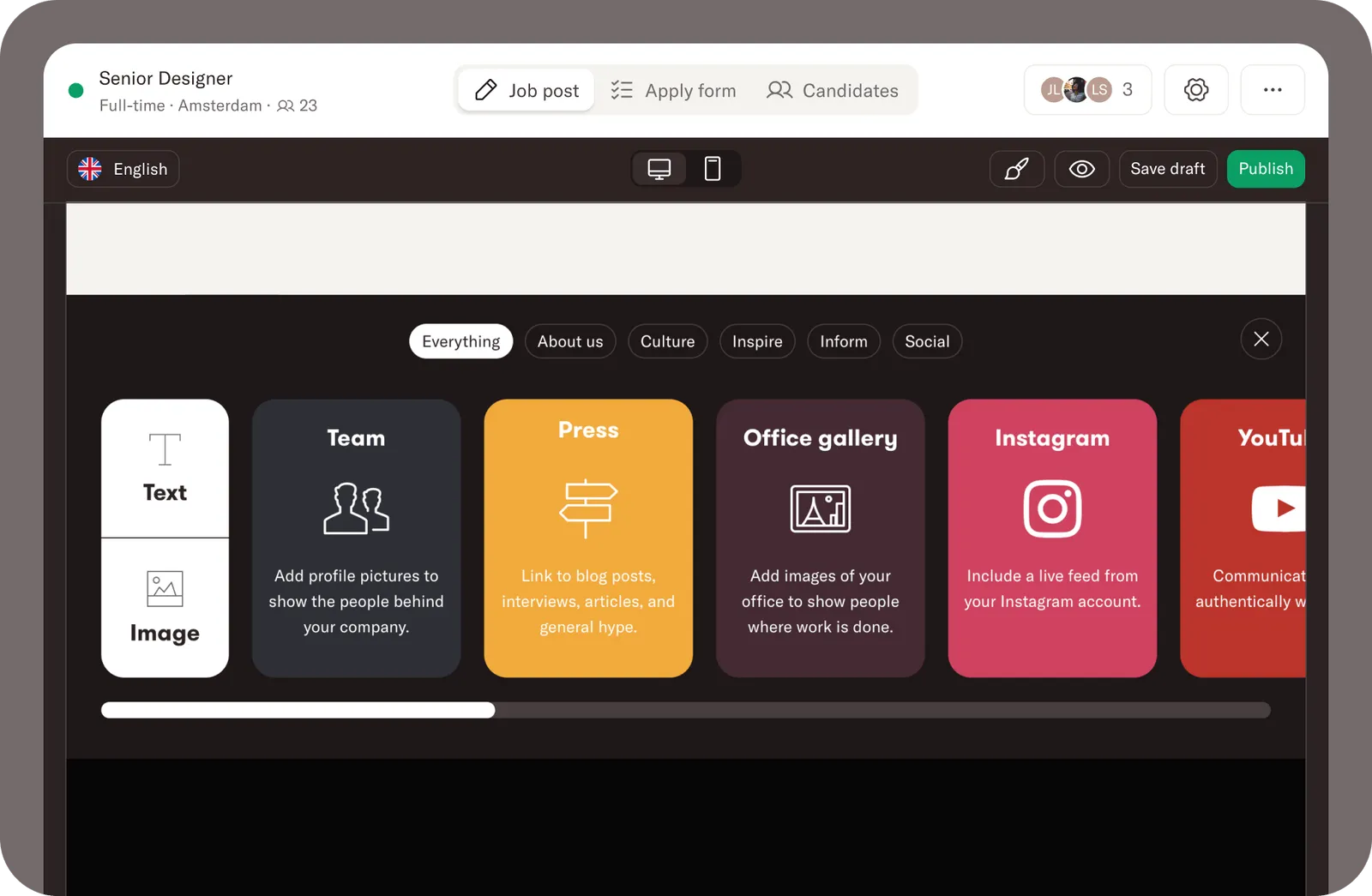
Oftentimes, we're excited about the prospect of bringing on a new team member, but it's the process that can make us feel a bit deflated. Hiring is indeed complex and time-consuming, but with a few tweaks, you can transform the entire experience for you and your candidates.
Our Head of People, Rita Wittek-Verbeek, recently sat down with HoorayHR's Theo Schroen to share examples of successful hiring and onboarding processes along with some practical tips and dos and don'ts.
Rita and Theo both agree that for teams to grow in a smooth and scalable way, hiring and onboarding processes always need to be assessed and improved. That's why they hosted the insight-packed webinar, Hire to Inspire: How to create an unforgettable candidate experience and boost retention.
Let's get right into those tips for attracting talent, improving the candidate experience and boosting retention.
Tip #1: Find out why people enjoy being part of your team
You know you have a unique company culture, but what are the specific reasons why people enjoy working there? What are the things you do together that are the most fulfilling?
Rita shares, "A strong employer brand can really reflect who you are as a company and what it's like to work there, but it shouldn't be just marketing. It should originate in your team. It's really, really important to know what your employee value proposition is so that you know what you're actually offering to future candidates."
For example, HoorayHR has reflected on this as a team and Theo says they've identified two key values:
- "We always say, 'Please make mistakes,' because we think that it's really important that people take initiative and do things themselves. You need to remind people that it's okay to make mistakes and please do, because then you develop yourself and you grow as a person."
- "The other part is that we are a smaller company and that means there's more bonding between team members. We want to get people enthusiastic about doing things together – like working together, thinking of new solutions together and sharing knowledge. That makes the company thrive faster and it’s also more fun to do it together."
Understanding and communicating your employer brand is the first step in attracting talent. Even as a small company, there are plenty of ways you can stand out. This leads us to tip #2!
Tip #2: Stand out with storytelling
Use storytelling to communicate your company culture and values in your job post and career page. This is your chance to get creative! You can start by displaying your values in a clear and aesthetically-pleasing way.
At Homerun, for example, we put our values front and center on our career page.
Rita explains, "As one of our Unique Selling Points, we have this value Keep your balance, and we illustrate it by telling people about how flexible we actually are. We have a 4-day work week at Homerun and so everyone gets paid for five days but works four, because we noticed that quite a lot of people have caretaking responsibilities and this really helps them out."
There are many, many ways you can highlight your company's USPs and personality in your job post. For example, you can add a photo gallery, a team Spotify playlist, your Instagram feed or a short video from the Team Lead to give candidates a better sense of who they'll be working with and what matters to your team.

📣 For more creative ways to stand out with storytelling, check out this showcase of job posts and career pages we love
Tip #3: Make hiring a team sport
Hiring is so much better when done together. In fact, many teams find success (and much more enjoyment) in collaborative hiring.
Collaborative hiring means coming together as a team to:
- recommend candidates 👥
- provide images, quotes and/or copy for your career page 📸
- write copy for job posts ✍️
- design job posts 🖥️
- share job posts 📲
People on your core hiring team can:
- choose job application questions ❓
- source candidates 🧲
- review applications 👀
- create or choose assessments 📝
- interview 🗣️
- provide feedback 💭
- message candidates 📧
At Homerun, hiring is embedded into our team and processes. Rita explains, "A good way to do this is if you're working with something like OKRs or any other goal-setting system, make hiring a part of that. If you need to find a new colleague in Q1, then it should be someone's objective and someone should be held accountable for that."
She adds that building in time for hiring is key, "because it does take a lot of time, it costs a lot of money and bad hires also cost a lot of money. So in the end you can also make a business case to add all the hiring activities into your goal-setting system."
Tip #4: Put yourself out there and find candidates
Building off the last tip, your entire team can help find and connect with candidates by:
👀 Looking for people within their own Slack communities – Hiring a Software Engineer? Have your current Engineers connect with people in their Slack communities or share the job post there.
🤝 Attending Meetups and other social events – These are great opportunities to scout possible new colleagues and build relationships.
🎉 Having sourcing parties – Rita explains, "You sit down, you look at LinkedIn profiles together with your team and then you can craft outreach emails." Make it a party by playing your favorite tunes, getting pizza or having special snacks.
✍️ Sending personalized messages to candidates – Rita notes that if a Team Lead sends a personalized message or email, "the candidate will be much more likely to reply than if it's a random recruiter who just says, 'Hey I saw your profile LinkedIn. Are you up for a chat?'"
Theo doubles down on this last point, saying, "That's one of the main reasons why I reach out to people. We tried out recruiters, but then people don't reply and you don't get the conversation started. You want to know who that person is and what they need. What are their expectations and where do they want to go with their career? It really helps to make contact yourself."
Tip #5: Interview with purpose (and combat bias)
You want to conduct interviews that are informative and personal without crossing the line. Rita says that a few years ago, someone said to her husband in an interview, "'Oh you look young. How old are you?' It's inappropriate and it doesn't matter."
Just a friendly reminder that during an interview it's not okay to ask:
- someone's age
- their marital status
- their current salary
Rita clarifies, "If people offer up information, if they tell you, 'I'm a mom of two,' that's great and then you'll know something about the person, but it doesn't mean that they will need more time off. You don't know anything about them so let people tell you about themselves and don't fish for information."
Sometimes it feels more comfortable to chat freely in interviews, but if you want to reduce hiring bias, you need structured interview questions to get the information you need to make a hiring decision.
"Something that we've been doing for years now which works really well," reveals Rita, "is after the interview, people don't talk to each other." This helps to avoid conformity bias.
"So if you and your colleague have an interview with a candidate, once it's over it's really tempting to start talking about the candidate, but that's where bias comes in. That's really not great because we are all biased. We know it and that's not a problem. It's how we handle bias. So train your team. After the interview, go your separate ways and write everything down immediately." ✍️
Tip #6: Treat your candidates like they are customers
Are your candidates happy with your hiring process? How do you know?
"I approach our employee experience at Homerun as I would building a product," says Rita, "because that requires continuous improvement, and so does your candidate experience. So in this scenario, our candidates are my customers and I'm trying to get these customers to sign up for Homerun as an employee. I want them to join, which is why I need to add to our hiring experience and I need to get feedback."
She goes on, "So during the hiring process, I also ask them how they experience the interviews or the process. Once someone joins, I do the same."
Rita concludes, "If you build a really good product (in this case the product is your hiring process), you will attract better candidates and those candidates will turn into employees. And they will be good employees because you found the right people and the return on investment will be higher as well."
Tip #7: Invest in a longer hiring process
Sometimes you feel like you need a new team member yesterday, but if you can take some extra time with the hiring process to find the right person, it really pays off.
Theo says he's used to waiting 2-3 months for someone to start. He adds, "Maybe someone can start in one month, but sometimes they are really loyal to their current employer and then I say, 'Take your time. Do you need two months? That's fine by us.'"
He says to encourage a long-term relationship and to help new hires feel good about the way they exit their current job, it's better to "give a little space. If it takes an extra month, it's okay."
Rita concurs. She notes, "A lot of companies look at time-to-hire [as a success metric]. We don't use that at Homerun because we prefer taking more time to hire if it leads to the right candidate in the end. We'd rather have someone stay on longer and we've noticed that a more thorough hiring process leads to that."
Tip #8: Get on the pre-boarding train
Rita says pre-boarding practices that go beyond admin are not only important but gaining traction.
Theo emphasizes, "You see from surveys that almost 30% of employees leave the company in the first half year if onboarding is not done right. So think about the process and how you can onboard someone even before they start."
He suggests staying in contact with the new hire in the weeks (or in some cases months) leading up to their first day of work. For example, he says, you can "send a card with a team invite. Invite the new hire to a Friday afternoon meeting so that he or she is involved in the team before they even start."
In the end, says Theo, you want to ensure "a smooth start and a warm welcome."
📣 With the Homerun x HoorayHR integration candidate information captured in Homerun's ATS is transferred to HoorayHR in just a few clicks. This eliminates manual data entry for your new hires and creates a smoother onboarding process.
Tip #9: Always be transparent
Transparency in the hiring process is crucial. Candidates appreciate knowing the hiring steps in advance and what to expect. (This also helps neurodiverse candidates to better prepare.)
Take time to share your hiring process in your job post or on your career page, and interview details (e.g. who will participate, length of time, and discussion topics) when sending an interview invitation email.
Here is an example of our hiring process which lives on our career page and we also share with Homerun applicants.
Job candidates and employees alike value transparency. In our recent hiring & onboarding survey, more than half of respondents said they’ll focus on better communication and transparency to improve retention in 2024.
Rita summarizes, "Transparency is really important, and it should start in the hiring process. It doesn't have to be something like making all the salaries transparent on day one or anything like that. You can start really small by asking people what they want transparency about.
- Do they want to know how decisions are made?
- Do they want to know what the monthly recurring revenue is?
There are different kinds of transparency and metrics. It sounds scary, and it's become a bit of a buzzword, but it's basically about honest communication."
Tip #10: Highlight your unique perks and benefits
When sharing your perks and benefits with candidates, you need to focus on what makes you special.
Rita admits, "I think we've all seen job posts that list things that shouldn't really be in there. Generally in Europe, there are a lot of good benefits that are mandated by law. So it's not special to tell people that they are allowed to call in sick or that they have 20 or 25 holidays a year or that they get a lunch break because basically, you have to offer these things."
In her opinion, it's better to share what kind of opportunities there are within the company to learn from others, to talk about how you celebrate wins or deal with mistakes, because, "That's much more important for employees to know. I'm not saying you shouldn't say that you have regular pizza nights or whatever it may be because that's nice too, but it's not what will make someone stick around for five years."
If you don't have an official benefits scheme in place or you think yours needs an overhaul, Rita recommends talking to your team about what would be important to them. She adds, "If you lock yourself up in your high tower and work on a benefits scheme without talking to people, they won't be able to tell you what they need."
She points out, "We're not all Big Tech with these huge benefits, but people also don't need them. Maybe you will find out that you have a lot of caretakers in your team and they would benefit from flexibility or you find out that a lot of people are saving for the down payment on their first house, so maybe they don't want to be part of a pension scheme and they would rather have more salary."
Determine what the most relevant and desirable benefits are for your team (for example, flexible work hours, a 25-hour week or remote options) and if you can make them work. These are just some of the elements that encourage people to want to join a company and stay.
Hire to inspire
Successful hiring is not just about filling positions. It's about creating relationships.
From treating candidates as customers and fostering a team-based approach to hiring to implementing a thoughtful pre-onboarding phase and meaningful benefits – focusing on the human element of hiring will ensure you stay on the right track.
For more powerful hiring tips and a list of dos and don'ts, watch the 30-minute webinar:



















.png)

